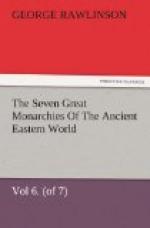Heliocles, who was allowed by his father a quasi-royal position, obtained the full possession of the Bactrian throne by the crime of parricide. It is conjectured that he regarded with disapproval his father’s tame submission to Parthian ascendency, and desired the recovery of the provinces which Eucratidas had been content to cede for the sake of peace. We are told that he justified his crime on the ground that his father was a public enemy; which is best explained by supposing that he considered him the friend of Bactria’s great enemy, Parthia. If this be the true account of the circumstances under which he became king, his accession would have been a species of challenge to the Parthian monarch, whose ally he had assassinated. Mithridates accordingly marched against him with all speed, and, easily defeating his troops, took possession of the greater part of his dominion. Elated by this success, he is said to have pressed eastward, to have invaded India, and overrun the country as far as the river Hydaspes, but, if it be true that his arms penetrated so far, it is, at any rate, certain that he did not here effect any conquest. Greek monarchs of the Bactrian series continued masters of Oabul and Western India till about B.C. 126; no Parthian coins are found in this region; nor do the best authorities claim for Mithridates any dominion beyond the mountains which enclose on the west the valley of the Indus.
By his war with Heliocles the empire of Mithridates reached its greatest extension. It comprised now, besides Parthia Proper, Bactria, Aria, Drangiana, Arachosia, Margiana, Hyrcania, the country of the Mardi, Media Magna, Susiana, Persia and Babylonia. Very probably its limits were still wider. The power which possessed Parthia, Hyrcania, and Bactria, would rule almost of necessity over the whole tract between the Elburz range and the Oxus, if not even over the region between the Oxus and the Jaxartes; that which held the Caspian mountains and eastern Media could not fail to have influence over the tribes of the Iranic desert; while Assyria Proper would naturally follow the fortunes of Babylonia and Susiana. Still the extent of territory thus indicated rests only on conjecture. If we confine ourselves to what is known by positive evidence, we can only say that the Parthian Kingdom of this period contained, at least, twelve provinces above enumerated. It thus stretched from east to west a distance of fifteen hundred miles between the Suleiman mountains and the Euphrates, varying in width from three or four hundred miles—or even more—towards the west and east, to a narrow strip of less than a hundred miles toward the centre. It probably comprised an area of about 450,000 square miles; which is somewhat less than that of the modern Persia.




